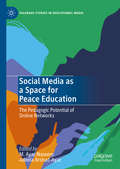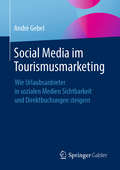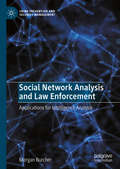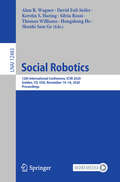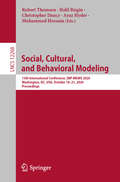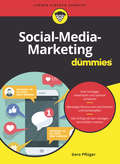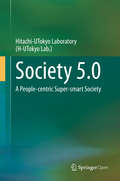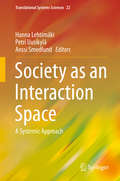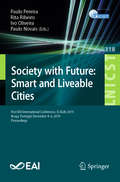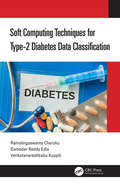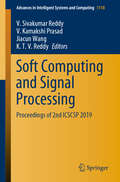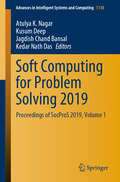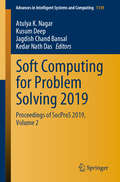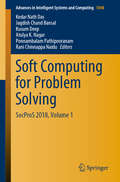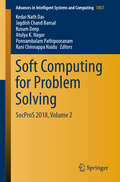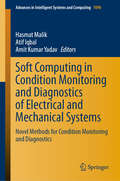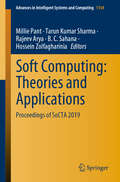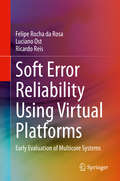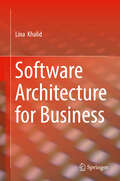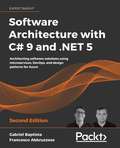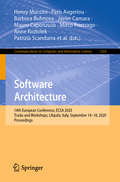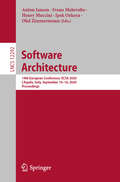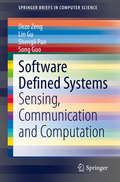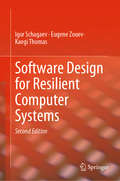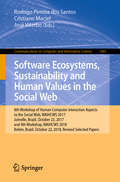- Table View
- List View
Social Media as a Space for Peace Education: The Pedagogic Potential of Online Networks (Palgrave Studies in Educational Media)
by M. Ayaz Naseem Adeela Arshad-AyazThis book explores the potential of social media as a space for teaching and bringing about sustainable peace. Using cutting-edge research, the editors and authors analyze the fundamental transformations taking place in the digital and interactive public sphere, most recently with the advent of the ‘post-truth’ age and the impact of this upon young people’s perceptions of ‘friend’ and ‘foe’. Peace initiatives at almost every level recognize the importance of education for sustainable peace: this volume examines the opportunities emerging from these societal transformations for both formal and informal education. This book will appeal to students and scholars of social media, peace education and the post-truth age.
Social Media im Tourismusmarketing: Wie Urlaubsanbieter in sozialen Medien Sichtbarkeit und Direktbuchungen steigern
by André GebelDieses Buch erklärt, wie Hotels, Regionen, Airlines und weitere touristische Anbieter mithilfe von Social Media höhere Sichtbarkeit, mehr Empfehlungen, mehr Direktbuchungen und somit mehr Gewinn erzielen können. Durch die Angebotstransparenz im Internet wird der Feriengast zum vermeintlich besten Angebot geführt, was sinkende Margen und steigende Abhängigkeit für die Reisebranche zur Folge hat. Zwar galt Social Media schon früher als Erfolgsrezept für die margenschwache Tourismusindustrie, doch vereinzelte Facebook-Posts und ein vernachlässigter Instagram-Account geben noch kein eigenständiges Profil ab – und bewegen keinen potenziellen Urlauber zur Direktbuchung.Anhand von anschaulichen Praxisbeispielen zeigt der Autor in diesem Buch, wie Tourismusanbieter Social Media professionell und strukturiert für Direktbuchungen nutzen können, welche Rolle Mitarbeiter und Influencer spielen, was die einzelnen Kanäle genau leisten und wie man mit außergewöhnlichem Storytelling Auslastungen jenseits der 90-Prozent-Marke erreicht. Ein Buch für alle Player der Reisebranche, die ihr Profil schärfen, ihre Margen vergrößern und neue Marketingkanäle entdecken wollen, um auch künftig wettbewerbsfähig zu bleiben.
Social Network Analysis and Law Enforcement: Applications for Intelligence Analysis (Crime Prevention and Security Management)
by Morgan BurcherThis book examines the use of social network analysis (SNA) in operational environments from the perspective of those who actually apply it. A rapidly growing body of literature suggests that SNA can reveal significant insights into the overall structure of criminal networks as well as the position of critical actors within such groups. This book draws on the existing SNA and intelligence literature, as well as qualitative interviews with crime intelligence analysts from two Australian state law enforcement agencies to understand its use by law enforcement agencies and the extent to which it can be used in practice. It includes a discussion of the challenges that analysts face when attempting to apply various network analysis techniques to criminal networks. Overall, it advances SNA as an investigative tool, and provides a significant contribution to the field that will be of interest to both researchers and practitioners interested in social network analysis, intelligence analysis and law enforcement.
Social Robotics: 12th International Conference, ICSR 2020, Golden, CO, USA, November 14–18, 2020, Proceedings (Lecture Notes in Computer Science #12483)
by Thomas Williams Shuzhi Sam Ge Hongsheng He Alan R. Wagner Silvia Rossi David Feil-Seifer Kerstin S. HaringThis book constitutes the refereed proceedings of the 12th International Conference on Social Robotics, ICSR 2020, held in Golden, CO, USA, in November 2020. The conference was held virtually.The 57 full papers presented were carefully reviewed and selected from 101 submissions. The theme of the 2020 conference is Entertaining Robots. The papers focus on the following topics: human-robot trust and human-robot teaming, robot understanding and following of social and moral norms, physical and interaction design of social robots, verbal and nonverbal robot communication, interactive robot learning, robot motion and proxemics, and robots in domains such as education and healthcare.
Social, Cultural, and Behavioral Modeling: 13th International Conference, SBP-BRiMS 2020, Washington, DC, USA, October 18–21, 2020, Proceedings (Lecture Notes in Computer Science #12268)
by Robert Thomson Christopher Dancy Ayaz Hyder Halil Bisgin Muhammad HussainThis book constitutes the proceedings of the 13th International Conference on Social, Cultural, and Behavioral Modeling, SBP-BRiMS 2020, which was planned to take place in Washington, DC, USA. Due to the COVID-19 pandemic the conference was held online during October 18–21, 2020. The 33 full papers presented in this volume were carefully reviewed and selected from 66 submissions. A wide number of disciplines are represented including computer science, psychology, sociology, communication science, public health, bioinformatics, political science, and organizational science. Numerous types of computational methods are used, such as machine learning, language technology, social network analysis and visualization, agent-based simulation, and statistics.
Social-Media-Marketing für Dummies (Für Dummies)
by Gero PflügerKein Zweifel: Über soziale Medien erreichen Sie Ihre Kunden am besten, am authentischsten, am persönlichsten. Was kann Ihnen Besseres passieren, als wenn jemand Ihr Produkt beispielsweise auf Facebook mit einer persönlichen Empfehlung versieht? Allerdings ist die Komplexität von Social-Media-Marketing hoch und die Gefahr extrem groß, jede Menge Zeit und Geld in den sozialen Medien zu verpulvern. Dieses Buch senkt die Hürde für den Einsteiger ins Social-Media-Marketing und gibt Ihnen einen einfachen Leitfaden an die Hand, um erfolgreicher im Social Web zu werben. Finden Sie Ihren Wunschkunden, definieren Sie Ihre Ziele und Ihre Marketingstrategie passend zu Ihren Ressourcen und optimieren Sie Ihren Arbeitseinsatz. Werden Sie Ihr eigener Influencer!
Society 5.0: A People-centric Super-smart Society
by Hitachi-UTokyo LaboratoryThis open access book introduces readers to the vision on future cities and urban lives in connection with “Society 5.0”, which was proposed in the 5th Basic Science and Technology Plan by Japan’s national government for a technology-based, human-centered society, emerging from the fourth industrial revolution. The respective chapters summarize the findings and suggestions of joint research projects conducted by H-UTokyo Lab. Through the research collaboration and discussion, this book explores the future urban lives under the concept of “Society 5.0”, characterized by the key phrases of data-driven society, knowledge-intensive society, and non-monetary society, and suggests the directionality to which the concept should aim as Japan’s technology-led national vision. Written by Hitachi’s researchers as well as academics from a wide range of fields, including engineering, economics, psychology and philosophy at The University of Tokyo, the book is a must read for members of the general public interested in urban planning, students, professionals and researchers in engineering and economics.
Society as an Interaction Space: A Systemic Approach (Translational Systems Sciences #22)
by Anssi Smedlund Hanna Lehtimäki Petri UusikyläAs digitalization and social media are increasingly blurring the boundaries between traditional societal, political, and economic institutions, this book provides a cross-disciplinary examination of value co-creation. From various standpoints, it examines how institutions contribute to service ecosystems and how digitalization is transforming value co-creation in these ecosystems. Further, the book shares new perspectives on relational dynamics among government, companies, and citizens. These insights fill the gaps between service science and political science by integrating institutional logics into the concept of value co-creation. The book subsequently examines society as an interaction space. Topics discussed include the new logic and transformation mechanisms of economic activities, citizen participation, governance, and policy-making in the face of technological innovations, market-based reforms, and the risk of disconnect between citizens and policy-making. Here the focus is on value co-creation in complex adaptive systems where institutions, individuals, and businesses negotiate value and interests in networked relations. In closing, the book presents a range of empirical case studies on value co-creation, which provide examples of active networked citizenship, innovative governance and policy-making, democratic leadership, and trust-building dialogue among institutions. The studies address the context of Nordic countries, recognized as world-leading democracies. Pursuing a systems approach, the book articulates a social reality composed of interacting and interconnected elements that cannot be captured with only micro or macro levels of analysis. Service ecosystems are considered as configurations of people and technologies embedded in institutionalized rules, cultural meanings, and practices, offering valuable insights into the service-centered view of markets and society. Given the breadth and depth of its coverage, the book offers a valuable resource for all students and scholars interested in understanding and envisioning the future democratic landscape.
Society with Future: First EAI International Conference, SC4Life 2019, Braga, Portugal, December 4-6, 2019, Proceedings (Lecture Notes of the Institute for Computer Sciences, Social Informatics and Telecommunications Engineering #318)
by Rita Ribeiro Paulo Novais Paulo Pereira Ivo OliveiraThis book constitutes the refereed post-conference proceedings of the First International Conference on Society with Future: Smart and Liveable Cities, SC4Life 2019, which took place in Braga, Portugal, in December 2019. The 13 revised full papers were carefully reviewed and selected from 19 submissions. The conference has brought researchers, developers, and practitioners who are leveraging and develoing new knowledge on the topic of smart cities, offering more efficiency to main infrastructures, utilities and services, creating a sustainable urban environment that improves the quality of life for its citizens and enhances economic development.
Soft Computing Techniques for Type-2 Diabetes Data Classification
by Damodar Reddy Edla Venkatanareshbabu Kuppili Ramalingaswamy CherukuDiabetes Mellitus (DM, commonly referred to as diabetes, is a metabolic disorder in which there are high blood sugar levels over a prolonged period. Lack of sufficient insulin causes presence of excess sugar levels in the blood. As a result the glucose levels in diabetic patients are more than normal ones. It has symptoms like frequent urination, increased hunger, increase thirst and high blood sugar. There are mainly three types of diabetes namely type-1, type-2 and gestational diabetes. Type-1 DM occurs due to immune system mistakenly attacks and destroys the beta-cells and Type-2 DM occurs due to insulin resistance. Gestational DM occurs in women during pregnancy due to insulin blocking by pregnancy harmones. Among these three types of DM, type-2 DM is more prevalence, and impacting so many millions of people across the world. Classification and predictive systems are actually reliable in the health care sector to explore hidden patterns in the patients data. These systems aid, medical professionals to enhance their diagnosis, prognosis along with remedy organizing techniques. The less percentage of improvement in classifier predictive accuracy is very important for medical diagnosis purposes where mistakes can cause a lot of damage to patient’s life. Hence, we need a more accurate classification system for prediction of type-2 DM. Although, most of the above classification algorithms are efficient, they failed to provide good accuracy with low computational cost. In this book, we proposed various classification algorithms using soft computing techniques like Neural Networks (NNs), Fuzzy Systems (FS) and Swarm Intelligence (SI). The experimental results demonstrate that these algorithms are able to produce high classification accuracy at less computational cost. The contributions presented in this book shall attempt to address the following objectives using soft computing approaches for identification of diabetes mellitus. Introuducing an optimized RBFN model called Opt-RBFN. Designing a cost effective rule miner called SM-RuleMiner for type-2 diabetes diagnosis. Generating more interpretable fuzzy rules for accurate diagnosis of type2 diabetes using RST-BatMiner. Developing accurate cascade ensemble frameworks called Diabetes-Network for type-2 diabetes diagnosis. Proposing a Multi-level ensemble framework called Dia-Net for improving the classification accuracy of type-2 diabetes diagnosis. Designing an Intelligent Diabetes Risk score Model called Intelli-DRM estimate the severity of Diabetes mellitus. This book serves as a reference book for scientific investigators who need to analyze disease data and/or numerical data, as well as researchers developing methodology in soft computing field. It may also be used as a textbook for a graduate and post graduate level course in machine learning or soft computing.
Soft Computing and Signal Processing: Proceedings of 2nd ICSCSP 2019 (Advances in Intelligent Systems and Computing #1118)
by V. Kamakshi Prasad Jiacun Wang V. Sivakumar Reddy K. T. V. ReddyThis book presents selected research papers on current developments in the fields of soft computing and signal processing from the Second International Conference on Soft Computing and Signal Processing (ICSCSP 2019). The respective contributions address topics such as soft sets, rough sets, fuzzy logic, neural networks, genetic algorithms and machine learning, and discuss various aspects of these topics, e.g. technological considerations, product implementation, and application issues.
Soft Computing for Problem Solving 2019: Proceedings of SocProS 2019, Volume 1 (Advances in Intelligent Systems and Computing #1138)
by Kedar Nath Das Kusum Deep Jagdish Chand Bansal Atulya K. NagarThis book features the outcomes of the 9th International Conference on Soft Computing for Problem Solving, SocProS 2019, which brought together researchers, engineers and practitioners to discuss thought-provoking developments and challenges in order to identify potential future directions. The book presents the latest advances and innovations in the interdisciplinary areas of soft computing, including original research papers in areas such as algorithms (artificial immune systems, artificial neural networks, genetic algorithms, genetic programming, and particle swarm optimization) and applications (control systems, data mining and clustering, finance, weather forecasting, game theory, business and forecasting applications). It is a valuable resource for both young and experienced researchers dealing with complex and intricate real-world problems that cannot easily be solved using traditional methods.
Soft Computing for Problem Solving 2019: Proceedings of SocProS 2019, Volume 2 (Advances in Intelligent Systems and Computing #1139)
by Kedar Nath Das Kusum Deep Jagdish Chand Bansal Atulya K. NagarThis book features the outcomes of the 9th International Conference on Soft Computing for Problem Solving, SocProS 2019, which brought together researchers, engineers and practitioners to discuss thought-provoking developments and challenges in order to identify potential future directions. The book presents the latest advances and innovations in the interdisciplinary areas of soft computing, including original research papers in areas such as algorithms (artificial immune systems, artificial neural networks, genetic algorithms, genetic programming, and particle swarm optimization) and applications (control systems, data mining and clustering, finance, weather forecasting, game theory, business and forecasting applications). It is a valuable resource for both young and experienced researchers dealing with complex and intricate real-world problems that cannot easily be solved using traditional methods.
Soft Computing for Problem Solving: SocProS 2018, Volume 1 (Advances in Intelligent Systems and Computing #1048)
by Kedar Nath Das Kusum Deep Jagdish Chand Bansal Atulya K. Nagar Ponnambalam Pathipooranam Rani Chinnappa NaiduThis two-volume book presents the outcomes of the 8th International Conference on Soft Computing for Problem Solving, SocProS 2018. This conference was a joint technical collaboration between the Soft Computing Research Society, Liverpool Hope University (UK), and Vellore Institute of Technology (India), and brought together researchers, engineers and practitioners to discuss thought-provoking developments and challenges in order to select potential future directions. The book highlights the latest advances and innovations in the interdisciplinary areas of soft computing, including original research papers on algorithms (artificial immune systems, artificial neural networks, genetic algorithms, genetic programming, and particle swarm optimization) and applications (control systems, data mining and clustering, finance, weather forecasting, game theory, business and forecasting applications). It offers a valuable resource for both young and experienced researchers dealing with complex and intricate real-world problems that are difficult to solve using traditional methods.
Soft Computing for Problem Solving: SocProS 2018, Volume 2 (Advances in Intelligent Systems and Computing #1057)
by Kedar Nath Das Kusum Deep Jagdish Chand Bansal Atulya K. Nagar Ponnambalam Pathipooranam Rani Chinnappa NaiduThis two-volume book presents the outcomes of the 8th International Conference on Soft Computing for Problem Solving, SocProS 2018. This conference was a joint technical collaboration between the Soft Computing Research Society, Liverpool Hope University (UK), and Vellore Institute of Technology (India), and brought together researchers, engineers and practitioners to discuss thought-provoking developments and challenges in order to select potential future directions. The book highlights the latest advances and innovations in the interdisciplinary areas of soft computing, including original research papers on algorithms (artificial immune systems, artificial neural networks, genetic algorithms, genetic programming, and particle swarm optimization) and applications (control systems, data mining and clustering, finance, weather forecasting, game theory, business and forecasting applications). It offers a valuable resource for both young and experienced researchers dealing with complex and intricate real-world problems that are difficult to solve using traditional methods.
Soft Computing in Condition Monitoring and Diagnostics of Electrical and Mechanical Systems: Novel Methods for Condition Monitoring and Diagnostics (Advances in Intelligent Systems and Computing #1096)
by Atif Iqbal Hasmat Malik Amit Kumar YadavThis book addresses a range of complex issues associated with condition monitoring (CM), fault diagnosis and detection (FDD) in smart buildings, wide area monitoring (WAM), wind energy conversion systems (WECSs), photovoltaic (PV) systems, structures, electrical systems, mechanical systems, smart grids, etc. The book’s goal is to develop and combine all advanced nonintrusive CMFD approaches on a common platform. To do so, it explores the main components of various systems used for CMFD purposes.The content is divided into three main parts, the first of which provides a brief introduction, before focusing on the state of the art and major research gaps in the area of CMFD. The second part covers the step-by-step implementation of novel soft computing applications in CMFD for electrical and mechanical systems. In the third and final part, the simulation codes for each chapter are included in an extensive appendix to support newcomers to the field.
Soft Computing: Proceedings of SoCTA 2019 (Advances in Intelligent Systems and Computing #1154)
by Millie Pant Tarun Kumar Sharma Rajeev Arya B. C. Sahana Hossein ZolfaghariniaThis book focuses on soft computing and how it can be applied to solve real-world problems arising in various domains, ranging from medicine and healthcare, to supply chain management, image processing and cryptanalysis. It gathers high-quality papers presented at the International Conference on Soft Computing: Theories and Applications (SoCTA 2019), organized by the National Institute of Technology Patna, India. Offering valuable insights into soft computing for teachers and researchers alike, the book will inspire further research in this dynamic field.
Soft Error Reliability Using Virtual Platforms: Early Evaluation of Multicore Systems
by Ricardo Reis Felipe Rocha da Rosa Luciano OstThis book describes the benefits and drawbacks inherent in the use of virtual platforms (VPs) to perform fast and early soft error assessment of multicore systems. The authors show that VPs provide engineers with appropriate means to investigate new and more efficient fault injection and mitigation techniques. Coverage also includes the use of machine learning techniques (e.g., linear regression) to speed-up the soft error evaluation process by pinpointing parameters (e.g., architectural) with the most substantial impact on the software stack dependability. This book provides valuable information and insight through more than 3 million individual scenarios and 2 million simulation-hours. Further, this book explores machine learning techniques usage to navigate large fault injection datasets.
Software Architecture for Business
by Lina KhalidThis book illustrates the role of software architecture and its application in business. The author describes enterprise architecture along with business architecture to show the role of software architecture in both areas. The place of software architecture in business is outlined from many perspectives in this context. The book outlines quality attributes and how managers can use software architecture to build high quality products. Topics include business software architecture, dealing with qualities, achieving quality attributes, managing business qualities, software product line, Internet of Things (IOT), and Service Oriented Business Architecture. The book is intended to benefit students, researchers, software architects, and business architects. Provides quick and easy access to all the important aspects of software architecture in business;Highlights a wide variety of concepts of software architecture in a straightforward manner, for students, practitioners, or architects;Presents different applications of software architecture in business.
Software Architecture with C# 9 and .NET 5 - Second Edition
by Gabriel BaptistaThis book is for engineers and senior software developers aspiring to become architects or looking to build enterprise applications with the .NET Stack. Basic familiarity with C# and .NET is required to get the most out of this book.
Software Architecture: 14th European Conference, ECSA 2020 Tracks and Workshops, L'Aquila, Italy, September 14–18, 2020, Proceedings (Communications in Computer and Information Science #1269)
by Danny Weyns Uwe Zdun Anne Koziolek Paris Avgeriou Mauro Caporuscio Henry Muccini Barbora Buhnova Javier Camara Mirco Franzago Patrizia Scandurra Catia TrubianiThis book constitutes the refereed proceedings of the tracks and workshops which complemented the 14th European Conference on Software Architecture, ECSA 2020, held in L'Aquila, Italy*, in September 2020. The 30 full papers and 9 short papers presented in this volume were carefully reviewed and selected from 72 submissions. Papers presented were accepted into the following tracks and workshops: ECSA 2020 Doctoral Symposium track; ECSA 2020 Tool Demos track; ECSA 2020 Gender Diversity in Software Architecture &Software Engineering track; CASA - 3rd International Workshop on Context-aware, Autonomous and Smart Architecture; CSE/QUDOS - Joint Workshop on Continuous Software Engineering and Quality-Aware DevOps; DETECT - 3rd International Workshop on Modeling, Verication and Testing of Dependable Critical Systems; FAACS-MDE4SA - Joint Workshop on Formal Approaches for Advanced Computing Systems and Model-Driven Engineering for Software Architecture; IoT-ASAP - 4th International Workshop on Engineering IoT Systems: Architectures, Services, Applications, and Platforms; SASI4 - 2nd Workshop on Systems, Architectures, and Solutions for Industry 4.0; WASA - 6th International Workshop on Automotive System/Software Architecture.*The conference was held virtually due to the COVID-19 pandemic.
Software Architecture: 14th European Conference, ECSA 2020, L'Aquila, Italy, September 14–18, 2020, Proceedings (Lecture Notes in Computer Science #12292)
by Olaf Zimmermann Anton Jansen Ivano Malavolta Henry Muccini Ipek OzkayaThis book constitutes the refereed proceedings of the 14th International Conference on Software Architecture, ECSA 2020, held in A’quila, Italy, in September 2020. In the Research Track, 12 full papers presented together with 5 short papers were carefully reviewed and selected from 103 submissions. They are organized in topical sections as follows: microservices; uncertainty, self-adaptive, and open systems; model-based approaches; performance and security engineering; architectural smells and source code analysis; education and training; experiences and learnings from industrial case studies; and architecting contemporary distributed systems. In the Industrial Track, 11 submissions were received and 6 were accepted to form part of these proceedings. In addition the book contains 3 keynote talks. Due to the Corona pandemic ECSA 2020 was held as an virtual event.
Software Defined Systems: Sensing, Communication and Computation (SpringerBriefs in Computer Science)
by Song Guo Deze Zeng Lin Gu Shengli PanThis book introduces the software defined system concept, architecture, and its enabling technologies such as software defined sensor networks (SDSN), software defined radio, cloud/fog radio access networks (C/F-RAN), software defined networking (SDN), network function virtualization (NFV), software defined storage, virtualization and docker. The authors also discuss the resource allocation and task scheduling in software defined system, mainly focusing on sensing, communication, networking and computation. Related case studies on SDSN, C/F-RAN, SDN, NFV are included in this book, and the authors discuss how these technologies cooperate with each other to enable cross resource management and task scheduling in software defined system. Novel resource allocation and task scheduling algorithms are introduced and evaluated. This book targets researchers, computer scientists and engineers who are interested in the information system softwarization technologies, resource allocation and optimization algorithm design, performance evaluation and analysis, next-generation communication and networking technologies, edge computing, cloud computing and IoT. Advanced level students studying these topics will benefit from this book as well.
Software Design for Resilient Computer Systems
by Igor Schagaev Eugene Zouev Kaegi ThomasThis book addresses the question of how system software should be designed to account for faults, and which fault tolerance features it should provide for highest reliability. With this second edition of Software Design for Resilient Computer Systems the book is thoroughly updated to contain the newest advice regarding software resilience. With additional chapters on computer system performance and system resilience, as well as online resources, the new edition is ideal for researchers and industry professionals.The authors first show how the system software interacts with the hardware to tolerate faults. They analyze and further develop the theory of fault tolerance to understand the different ways to increase the reliability of a system, with special attention on the role of system software in this process. They further develop the general algorithm of fault tolerance (GAFT) with its three main processes: hardware checking, preparation for recovery, and the recovery procedure. For each of the three processes, they analyze the requirements and properties theoretically and give possible implementation scenarios and system software support required. Based on the theoretical results, the authors derive an Oberon-based programming language with direct support of the three processes of GAFT. In the last part of this book, they introduce a simulator, using it as a proof of concept implementation of a novel fault tolerant processor architecture (ERRIC) and its newly developed runtime system feature-wise and performance-wise. Due to the wide reaching nature of the content, this book applies to a host of industries and research areas, including military, aviation, intensive health care, industrial control, and space exploration.
Software Ecosystems, Sustainability and Human Values in the Social Web: 8th Workshop of Human-Computer Interaction Aspects to the Social Web, WAIHCWS 2017, Joinville, Brazil, October 23, 2017 and 9th Workshop, WAIHCWS 2018, Belém, Brazil, October 22, 2018, Revised Selected Papers (Communications in Computer and Information Science #1081)
by José Viterbo Cristiano Maciel Rodrigo Pereira dos SantosThis book constitutes extended revised selected papers presented during the 8th Workshop of Human-Computer Interaction Aspects to the Social Web, WAIHCWS 2017, held in Joinville, Brazil, in October 2017, and during the 9th Workshop of Human-Computer Interaction Aspects to the Social Web, WAIHCWS 2018, held in Belém, Brazil, in October 2018. The 5 full papers presented were thoroughly reviewed and selected from 14 submissions for WAIHCWS 2017 and 3 full papers were selected for publication from 20 submissions for WAIHCWS 2018. The authors were given the opportunity to extend and revise the papers after the conference. The topics included in this volume cover the following fields connected to the social web: user experience, emotion analysis, interoperability, systems-of-information systems, knowledge-intensive processes, ontology, transportation domain, mobile systems, privacy policies, digital legacy, social networks, recommendation models, scientific events, accessible web, software ecosystems, and sustainability.
